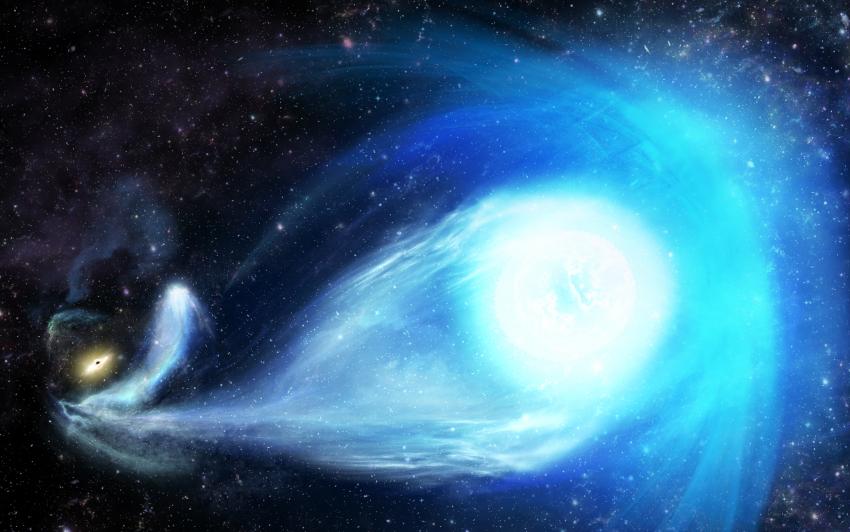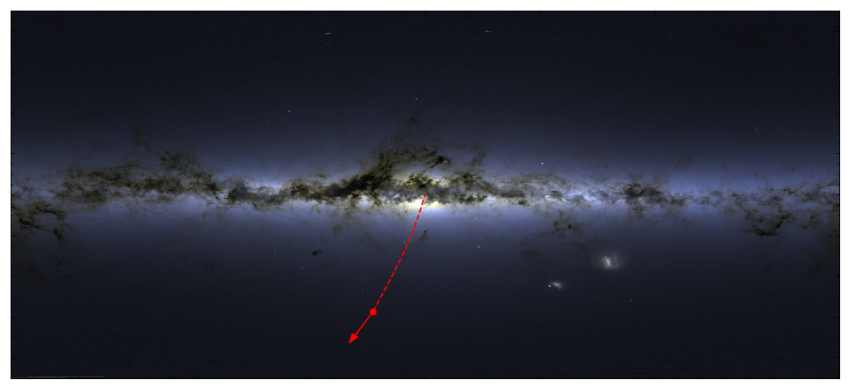Astronomers have spotted an ultrafast star, travelling at a blistering 6 million km/h, ejected by the supermassive black hole at the heart at the Milky Way five million years ago. The discovery is described in a new paper in the journal Monthly Notices of the Royal Astronomical Society.
The discovery of the star, known as S5-HVS1, was made by Sergey Koposov from Carnegie Mellon University as part of the Southern Stellar Stream Spectroscopic Survey (S5). Located in the constellation of Grus – the Crane – S5-HVS1 was found to be moving ten times faster than most stars in the Milky Way.
“The velocity of the discovered star is so high that it will inevitably leave the Galaxy and never return”, said Douglas Boubert from the University of Oxford, a co-author on the study.
Astronomers have wondered about high velocity stars since their discovery only two decades ago. S5-HVS1 is unprecedented due to its high speed and close passage to the Earth, “only” 29 thousand light years away. With this information, astronomers could track its journey back into the centre of the Milky Way, where a 4 million solar mass black hole, known as Sagittarius A*, lurks.
“This is super exciting, as we have long suspected that black holes can eject stars with very high velocities. However, we never before had a clear association of such a fast star with the Galactic Centre,” said Sergey Koposov, the lead author of this work. “We think the black hole ejected the star with a speed of thousands of kilometres per second about five million years ago. This ejection happened at the time when humanity’s ancestors were just learning to walk on two feet."
Superfast stars can be ejected by black holes via the Hills Mechanism, proposed by astronomer Jack Hills thirty years ago. Originally, S5-HSV1 lived with a companion in a binary system, but they strayed too close to Sagittarius A*. In the gravitational tussle, the companion star was captured by the black hole, while S5-HVS1 was thrown out at extremely high speed.
“This is the first clear demonstration of the Hills Mechanism in action,” said Ting Li from Carnegie Observatories and Princeton University, and leader of the S5 Collaboration. “Seeing this star is really amazing as we know it must have formed in the Galactic Centre, a place very different to our local environment. It is a visitor from a strange land.”
An animation of artist's impressions of the ejection of the star S5-HVS1 by the supermassive black hole at the centre of the Milky Way galaxy. Credit: James Josephides (Swinburne Astronomy Productions)
The discovery of S5-HVS1 was made with the 3.9-metre Anglo-Australian Telescope (AAT) near Coonabarabran, NSW, Australia, coupled with superb observations from the European Space Agency’s Gaia satellite that allowed the astronomers to reveal the full speed of the star and its journey from the centre of the Milky Way.
“The observations would not be possible without the unique capabilities of the 2dF instrument on the AAT,” said Daniel Zucker, an astronomer at Macquarie University in Sydney, Australia, and a member of the S5 Executive Committee. “It’s been conducting cutting-edge research for over two decades and still is the best facility in the world for our project.”
"I am so excited this fast-moving star was discovered by S5,” says Kyler Kuehn, at Lowell Observatory and a member of the S5 Executive Committee. “While the main science goal of S5 is to probe the stellar streams — disrupting dwarf galaxies and globular clusters — we dedicated spare resources of the instrument to searching for interesting targets in the Milky Way, and voila, we found something amazing for ‘free.’ With our future observations, hopefully we will find even more!”
Media contacts
Jocelyn Duffy
Associate Dean for Communications
Mellon College of Science
Carnegie Mellon University
Tel: +1 412-268-9982
jhduffy@andrew.cmu.edu
Robert Massey
Royal Astronomical Society
Tel: +44 (0)20 7292 3979
Mob: +44 (0)7802 877 699
press@ras.ac.uk
Morgan Hollis
Royal Astronomical Society
Mob: +44 (0)7802 877 700
press@ras.ac.uk
Science contacts
Sergey E. Koposov
Assistant Professor
The McWilliams Center for Cosmology
Carnegie Mellon University
United States
Tel: +1-412-268-2759
skoposov@cmu.edu
Douglas Boubert
Rudolf Peierls Centre for Theoretical Physics
Oxford
Tel: +44 (0)1865 273959
douglas.boubert@magd.ox.ac.uk
Ting S. Li
NASA Hubble (Einstein) Fellow
Carnegie-Princeton Fellow
Carnegie Observatories
United States
Tel: +1-626-304-0253
tingli@carnegiescience.edu
Images, animations and captions
https://ras.ac.uk/sites/default/files/2019-11/map.png
The location of the star S5-HVS1 on the sky and the direction of its motion. The star is flying away from the Galactic centre, from which it was ejected 5 million years ago.
Credit: Sergey Koposov
https://ras.ac.uk/sites/default/files/2019-11/HyperVelocityStar2.jpg
An artist’s impression of S5-HVS1’s ejection by Sagittarius A*, the black hole at the centre of the Galaxy. The black hole and the captured binary partner to S5-HVS1 are seen far away in the left corner of the picture, while S5-HVS1 is in the foreground, speeding away from them.
Credit: James Josephides (Swinburne Astronomy Productions)
https://youtu.be/V91iH6i-9-g
A movie of the view of the ejection of the S5-HVS1 star, as an observer from outside our galaxy would see it. The Sun is marked by an orange sphere, while the ejected star is shown by a blue sphere.
Credit: Sergey Koposov (CMU)
https://youtu.be/45NAQxmkhbQ
Caption: The video shows the motion of two stars as they orbit each other, as they approach the black hole, and then -- when the black hole comes close enough -- the binary system is destroyed and one of the stars (red one) is captured by the black hole, while the blue one is ejected with high speed.
Credit: Sergey Koposov (CMU)
Further information
The S5 collaboration website
The new work appears in “Discovery of a nearby 1700 km/s star ejected from the Milky Way by Sgr A*”, Sergey E. Koposov et al., Monthly Notices of the Royal Astronomical Society (2019), in press (DOI: 10.1093/mnras/stz3081).
A copy of the paper is available from: https://doi.org/10.1093/mnras/stz3081
Notes for editors
The Royal Astronomical Society (RAS), founded in 1820, encourages and promotes the study of astronomy, solar-system science, geophysics and closely related branches of science. The RAS organises scientific meetings, publishes international research and review journals, recognizes outstanding achievements by the award of medals and prizes, maintains an extensive library, supports education through grants and outreach activities and represents UK astronomy nationally and internationally. Its more than 4,000 members (Fellows), a third based overseas, include scientific researchers in universities, observatories and laboratories as well as historians of astronomy and others.
The RAS accepts papers for its journals based on the principle of peer review, in which fellow experts on the editorial boards accept the paper as worth considering. The Society issues press releases based on a similar principle, but the organisations and scientists concerned have overall responsibility for their content.Follow the RAS on Twitter, Facebook, Instagram and YouTube



